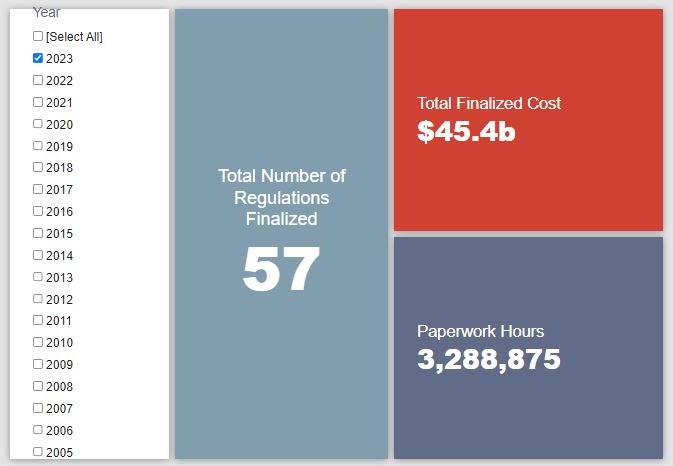Week in Regulation
May 1, 2023
A Heavy-duty End to April
The billions keep rolling in. Last week, there were 11 rulemakings with some measurable economic impact. This cohort of actions extended the weeks-long trend of costs in the billions of dollars. The main blockbuster of the week was the Environmental Protection Agency’s (EPA) latest round of greenhouse gas (GHG) emissions standards for heavy-duty vehicles. Across all rulemakings, agencies published $43.4 billion in total costs and added 1.8 million annual paperwork burden hours.
REGULATORY TOPLINES
- Proposed Rules: 37
- Final Rules: 48
- 2023 Total Pages: 26,417
- 2023 Final Rule Costs: $45.4 billion
- 2023 Proposed Rule Costs: $102.9 billion
NOTABLE REGULATORY ACTIONS
The most consequential rulemaking of the week was the proposed rule from EPA regarding “Greenhouse Gas Emissions Standards for Heavy-Duty Vehicles-Phase 3.” The proposal represents the latest salvo in EPA’s ongoing rulemakings seeking to make vehicles less carbon-intensive. In particular, this round would set “standards for heavy-duty highway vehicles starting in model year (MY) 2028 through MY 2032 and to revise certain GHG standards for MY 2027.” EPA expects the standards to reduce GHG emissions by 2.3 billion metric tons, but upfront costs will add up to roughly $39 billion. EPA is set to have a massive end to spring on the climate change regulatory front with a companion rulemaking on GHG emissions from light-duty vehicles and a new set of standards for power plants both forthcoming in the near future.
TRACKING THE ADMINISTRATIONS
As we have already seen from executive orders and memos, the Biden Administration will surely provide plenty of contrasts with the Trump Administration on the regulatory front. And while there is a general expectation that the current administration will seek to broadly restore Obama-esque regulatory actions, there will also be areas where it charts its own course. Since the AAF RegRodeo data extend back to 2005, it is possible to provide weekly updates on how the top-level trends of President Biden’s regulatory record track with those of his two most recent predecessors. The following table provides the cumulative totals of final rules containing some quantified economic impact from each administration through this point in their respective terms.
![]()
While the most significant action of the week came on the proposed rule side, there was still substantial movement in the Biden Administration’s final rule totals. Driven primarily by a Department of Health and Human Services (HHS) rule updating the “Notice of Benefit and Payment Parameters for 2024” for Affordable Care Act exchanges, Biden-era costs and paperwork increased by $3.4 billion and 590,000 hours, respectively. There was not, however, much to report on from the other administrations. Of note, the single most notable final rule across either administration was the Trump-era “Notice of Benefit and Payment Parameters for 2020” from HHS that made nominally deregulatory changes to the program resulting in nearly $58 million in estimated cost savings.
THIS WEEK’S REGULATORY PICTURE
This week, the Department of Transportation (DOT) seeks to have transit authorities update their safety plans.

Source: Photo by Andrew Wagner on Unsplash
Last Wednesday, DOT published a proposed rule regarding “Public Transportation Agency Safety Plans.” The rulemaking implements provisions of the Bipartisan Infrastructure Law that would have relevant public transit authorities update their overall safety protocols as a condition of receiving federal support. In particular, the proposal includes:
- “requirements for the development, update, and approval of Agency Safety Plans (ASP);
- the establishment of a Safety Committee; cooperation with frontline transit worker representatives in the development of ASPs;
- the establishment of a safety risk reduction program for transit operations to improve safety by reducing the number and rates of safety events, injuries, and assaults on transit workers based on data submitted to the National Transit Database (NTD);
- the establishment of safety performance targets for risk reduction programs;
- the establishment of de-escalation training for certain transit workers;
- and the incorporation of guidelines from the CDC or a State health authority regarding exposure to infectious diseases into the agency’s SMS processes.”
DOT expects covered transit authorities to spend “at least 0.75 percent” of the federal assistance they receive from the “Urbanized Area Formula Program funds under 49 U.S.C. 5307 (section 5307)” to institute these changes. While DOT expects its proposal to help offset some of the costs of the new requirements, the agency does not currently have the data to conclude how this will affect a given transit agency’s overall budgetary outlook given the disparity in potential baselines across the various covered authorities.
DOT is, however, able to calculate the costs that these transit agencies will bear in terms of reporting their compliance back to the agency. Total costs over a 10-year window add up to nearly $47 million (or $3.3 million annualized) with new paperwork requirements adding another 229,177 hours in administrative burdens each year. The costliest items in this estimate involve the establishment of the “Safety Committee” within each transit agency, as well as the expansion of “de-escalation training.”
Interested parties have until June 26, 2023, to submit comment.
TOTAL BURDENS
Since January 1, the federal government has published $148.3 billion in total net costs (with $45.4 billion in new costs from finalized rules) and 49.6 million hours of net annual paperwork burden increases (with 3.3 million hours in increases from final rules).











